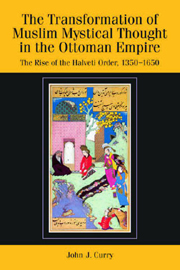 The Transformation of Muslim Mystical Thought in the Ottoman Empire
The Transformation of Muslim Mystical Thought in the Ottoman Empire from PART III - DEFENDING THE CULT OF SAINTS IN ELEVENTH/SEVENTEENTH-CENTURY KASTAMONU: TRANSFORMING THE ŞAcBÂNİYE ORDER UNDER cÖMER EL-FUɔÂDÎ
Published online by Cambridge University Press: 12 September 2012
cÖmer el-Fuɔâdî would likely have been a transitional figure in the history of the Şacbâniye whether he accepted the role or not. His accession to the successorship represented the de facto end of an era, for he held the distinction of being the first head of the Şacbâniye too young to have been trained in the Sufi path by Şacbân himself. This did not mean that he was entirely cut off from the founder, having known him as a child. He would, however, have been aware that Şacbân had predeceased the vast majority of Kastamonu's population by the time he came to power.
Fu'âdî was born some time in the year 967/1560 by his own account. He met Şacbân Efendi through the agency of his mother and father when he was a youth, and witnessed the events of Şacbân's funeral in the spring of 978/1569 at the age of nine. Still, his youth meant that he never had the chance to build a meaningful personal relationship with this towering figure, who by the beginning of the eleventh/seventeenth century had become increasingly remote from living memory. Fuɔâdî, despite some initial awkwardness, would eventually rise to the challenges raised by growing chronological distance and revive Şacbân-ı Veli's memory for future generations.
To save this book to your Kindle, first ensure [email protected] is added to your Approved Personal Document E-mail List under your Personal Document Settings on the Manage Your Content and Devices page of your Amazon account. Then enter the ‘name’ part of your Kindle email address below. Find out more about saving to your Kindle.
Note you can select to save to either the @free.kindle.com or @kindle.com variations. ‘@free.kindle.com’ emails are free but can only be saved to your device when it is connected to wi-fi. ‘@kindle.com’ emails can be delivered even when you are not connected to wi-fi, but note that service fees apply.
Find out more about the Kindle Personal Document Service.
To save content items to your account, please confirm that you agree to abide by our usage policies. If this is the first time you use this feature, you will be asked to authorise Cambridge Core to connect with your account. Find out more about saving content to Dropbox.
To save content items to your account, please confirm that you agree to abide by our usage policies. If this is the first time you use this feature, you will be asked to authorise Cambridge Core to connect with your account. Find out more about saving content to Google Drive.